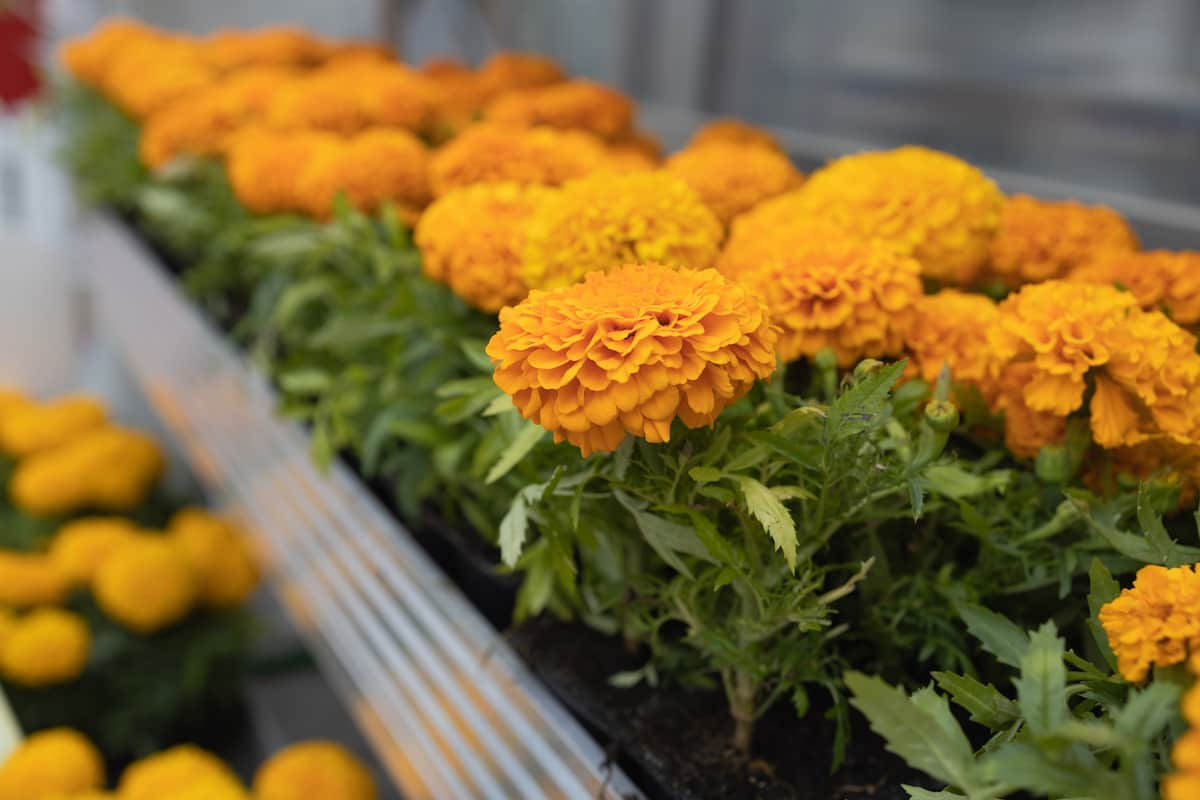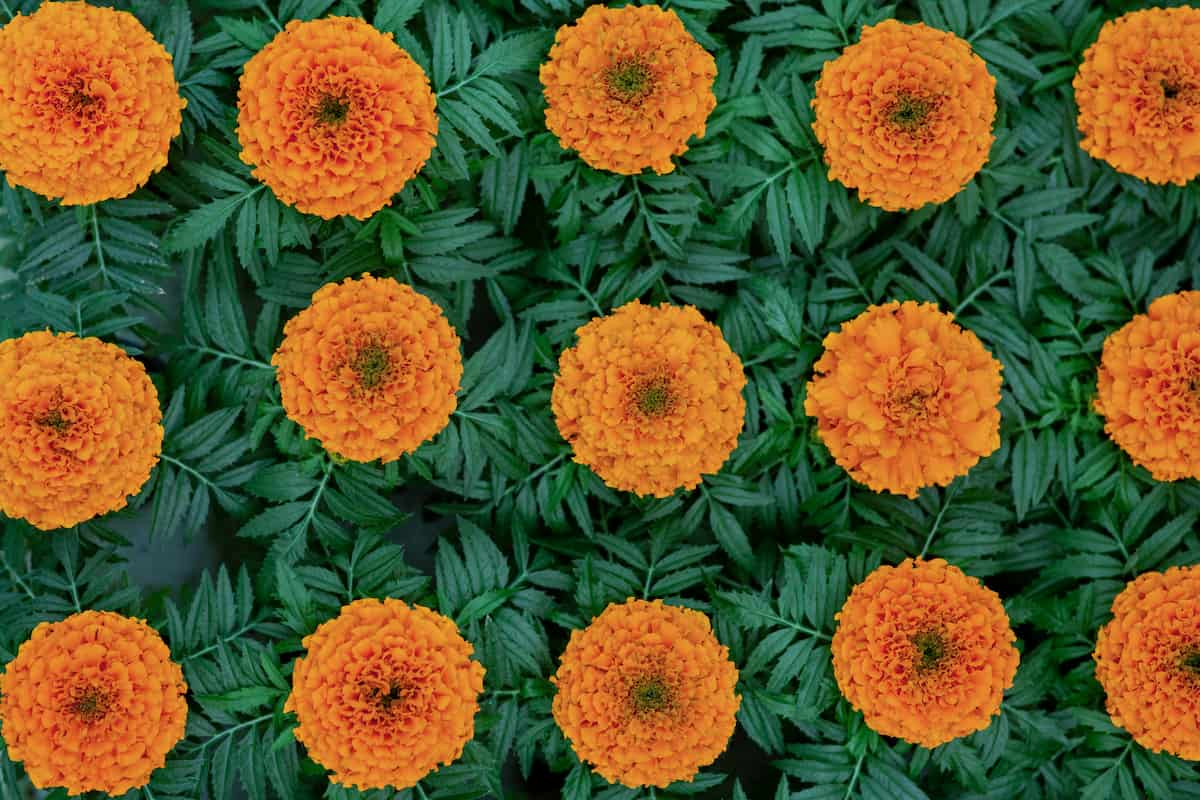Marigolds are one of the most popular annual flowers, easily grown from seeds or transplants, and when given the right conditions, they will blossom profusely. Most people remember growing Marigold flowers as one of their first flowers. They are often used in schools as gifts and growing projects because they are easy to care for and bright. Marigold flowers can still be grown in greenhouses today. Let’s take a look at how to grow Marigolds.

How to Grow Marigold in Greenhouse
Light Requirements for Marigold in the Greenhouse
Early spring crops need as much light as possible when it comes to Marigolds. Plant Marigold crops in the brightest areas of the production area, preferably with a glass or clear plastic glazing. Keeping the greenhouse glazing clean and free from shading compounds is important.
Different Kinds of Marigold Flowers
- African: These Marigold flowers tend to be tall
- French: These tend to be dwarf varieties
- Triploid: These Marigolds are a hybrid between African and French and are multi-colored
- Single: Have long stems and look like daisies.
Soil Requirements for Marigold in The Greenhouse
Marigolds are not particular about where they grow. Any good garden soil will work, as long as it’s not too acidic, along with a little water when it’s dry. The soil pH should range between 6.0 and 7.0. Organic matter is not necessary. They seem to thrive in soils that contain less organic matter. Compost or sand can be added to heavy garden soil to improve drainage.
Climate Requirements for Marigold In The Greenhouse
- For luxuriant growth and flowering, Marigolds require a mild climate.
- It grows best at temperatures between 18 and 20 degrees Celsius.
- Plants cannot grow at temperatures above 35°C, resulting in smaller and fewer flowers.
- Frost damages plants and flowers in severe winters.
Growing Marigolds from Seeds
- Read your seed packet carefully for all the necessary information about growing. In general, you should plant Marigold seeds four to six weeks before your last frost date.
- Make your seed starting mix, or fill your seedling tray with a lightly moistened seed starting mix.
- Seeds should be planted in a small seedling tray with several seeds per plug – press them about a quarter of an inch (about half a centimeter) into the soil.
- You should place your seedling tray under grow lights. Spray bottles or misters can be used to water seed starting containers (unless they have self-watering capabilities).
- You should avoid over-watering young Marigold seedlings. They are vulnerable to damping off, caused by a fungus or mold that develops in overly wet conditions. Ensure your seedlings are well-ventilated as well.
Transplanting of Seedlings in a Greenhouse
- Seedlings of Marigolds are easily transplanted and established in the field without much mortality.
- When transplanted, they should be stocky and bear 3-5 true leaves.
- Seedlings that are thin and long do not make good plants.
- Also, very old seedlings should be avoided.
- Plants should be transplanted on well-prepared land, and soil should be packed around the root zone to prevent air pockets from forming.
- Light irrigation or watering with rose cane should be done after transplanting.
- The growth habit, cultivar, and soil type of the plant largely determine the density of plants.
- For French Marigolds, spacing should be 30 cm x 30 cm, and for African Marigolds, 40 cm x 40 cm.
- For plants to develop properly and yield more flowers, proper spacing between them is required.
In case you missed it: How to Grow Dragon Fruit in a Greenhouse: A Step-By-Step Guide for Seed to Harvest

Water Requirements for Marigold in the Greenhouse
Marigolds need to be watered for the first week or two after planting to establish a strong root system. In summer, when temperatures are high, they need to be watered more frequently once established. You should avoid overhead watering to prevent the dense blooms from rotting and fungal growth on the leaves.
Fertilizer Requirements for Marigold in The Greenhouse
Fertilizing Marigolds after transplanting should be avoided until the roots reach the sides and bottom of the container. Following that, fertilize on a constant liquid basis at 100 to 150 ppm nitrogen, using a fertilizer containing about equal amounts of nitrogen and potassium. Once or twice a week, growers apply calcium nitrate and potassium nitrate or alternate between 20-10-20 and 15-0-15. Fertilizers with nitrogen high in ammonium form (greater than 40 percent), such as some 20-20-20 formulations, should not be used at temperatures below 18°C. It is recommended that growers test the medium pH and soluble salts.
Weeding Practices in Marigold
Marigolds are particularly susceptible to weed infestations during rainy seasons. The Marigold’s growth and production will be difficult if the weeds are not removed in time. In growth phases 3-4, manual weeding is required. Whenever necessary, a weeding should be done.
Pinching and Earthling Up
- Earthling up is done three weeks after transplanting, followed by transplanting the seedlings one month after earthling up.
- The plant’s bushy growth and lateral branches are stimulated by pinching.
- After transplantation, pinching is generally done for 40 days. The results of late pinching at 50-60 days were less effective for branching.
- There is an increase in flower production when pinching is done.
Staking and Trimming Marigold Plants
- Staking is not necessary for shorter varieties. For taller, cut flowers, staking is recommended so they won’t fall over when they bloom heavily.
- Even though Marigolds require relatively little deadheading compared to other annuals, removing dead blossoms and stems will encourage new growth and improve the overall appearance.
Pests in Marigold Grown in Greenhouse
- It is rare for Marigolds to be attacked by insect pests. Cabbage moths can be deterred and repelled by planting flowers around cabbage and broccoli plants.
- Spray a strong stream of water on soft-bodied pests, such as aphids and spider mites, to reduce their numbers
- Spray the insecticide on the Marigolds until all surfaces are wet. Aphids, thrips, and spider mites will be controlled by this method. If necessary, repeat the treatment every 7 to 10 days.
- Spray four teaspoons of Bacillus thuringiensis mixed with four liters of water liberally on Marigolds to kill chewing insects, such as leaf-eating caterpillars.
Diseases in Marigold Grown in Greenhouse
- The neem oil solution should be thoroughly mixed into a garden sprayer.
- Spray the Marigolds liberally with the solution until all plant parts are covered. Mildews, blights, and leaf spots will be controlled by this method.
- The treatment should be repeated every seven days until the disease has been eradicated. As a preventative measure, apply the neem oil solution every 14 days.
- Prevent diseases by avoiding overhead irrigation, excessive moisture, and poor air circulation between plants
- Marigolds may be affected by powdery mildew if conditions are excessively damp. Ensure not to get water on Marigold leaves, keep weeds at bay, and plant in well-drained soil to avoid fungal problems.
Harvesting Marigold Flowers
When the Marigold flowers are fully bloomed, they are ready for harvesting. In general, the more Marigolds are harvested, the more flowers will bloom. Fabric dyeing can also be done using freshly harvested Marigold flowers. Identify the Marigold clumps and cut them selectively. As long as you don’t remove too many stems at a time, you can harvest and continue growing throughout the season
In case you missed it: How to Grow Cloves in a Greenhouse: A Step-by-Step Guide for Seed to Harvest

Conclusion
Marigold is an excellent crop for rotation under framed structures such as greenhouses and shade net houses. Farmers used to grow Marigolds in open conditions, which made the farming susceptible to natural calamities, pests, and diseases. Additionally, they were unable to maintain or manage the crops. This led to the cultivation of Marigolds in greenhouses. As a result of this new cultivation method, the crop is more productive and pest and disease-free.
- Feed Your Flock for Less: Top 10 Tips to Save on Chicken Feed
- Ultimate Guide to Ossabaw Island Hog: Breeding, Raising, Diet, and Care
- Hatching Answers: The Top 10 Reasons Your Chickens Aren’t Laying Eggs
- Eggs and Economics: Breaking Down the Cost of Raising Backyard Chickens
- Defend Your Greens: Proven Methods to Keep Iguanas Out of Your Garden
- Ultimate Guide to Cinnamon Queen Chicken: A Comprehensive Guide for Beginners
- Ultimate Guide to California Tan Chicken: Breeding, Raising, Diet, Egg-Production and Care
- Ultimate Guide to Marsh Daisy Chicken: Breeding, Raising, Diet, and Care
- 10 Types of Chicken Farming Businesses You Can Start for Profits